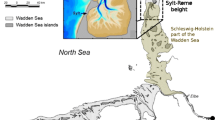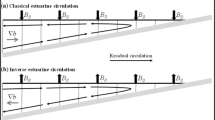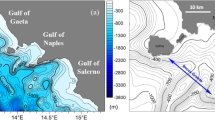Abstract
In this paper we use a combination of numerical modeling and data analysis to gain a better understanding of the major characteristics of the circulation in the East Frisian Wadden Sea. In particular, we concentrate on the asymmetry of the tidal wave and its modulation in the coastal area, which results in a complex pattern of responses to the sea-level forcing from the North Sea. The numerical simulations are based on the 3-D primitive equation General Estuarine Transport Model (GETM) with a horizontal resolution of 200 m and terrain-following vertical coordinates. The model is forced at its open boundaries with sea-level data from an operational model for the German Bight (German Hydrographic Office). The validation data for our model simulations include time series of tidal gauge data and surface currents measured at a pile in the back-barrier basin of the Island Langeoog, as well as several ADCP transects in the Accumer Ee tidal inlet.
Circulation and turbulence characteristics are investigated for typical situations driven by spring and neap tides, and the analysis is focused on dominating temporal and spatial patterns. By investigating the response of five back-barrier basins with rather different morphologies to external forcing, an attempt is made to elucidate the dominating physical balances controlling the circulation in the individual sub-basins. It is demonstrated that the friction at the seabed tends to slow down the tidal signal in the shallow water. This leads to the establishment of flood dominance in the shallow sea north of the barrier islands. South of the islands, where the water volume of the channels at low tide is smaller than the tidal prism, the asymmetry of the tidal signal is shifted towards ebb dominance, a feature which is particularly pronounced at spring tide.
At the northern open boundary, the tidal wave propagating from west to east generates a sea-level difference of ∼1 m along the boundary, and thereby triggers vigorous alongshore currents. The frictional control in the model is located in the inlets, as well as along the northern boundary. The correlation between velocity and turbulent kinetic energy tends to the establishment of a net southward transport, giving theoretical support to the observed accumulation of sediments on the intertidal flats. Weak turbulence along the northern shores of the barrier islands and the small magnitude of the residual currents there promote accumulation of suspended matter in these areas, although wave action will generally counteract this effect.
Similar content being viewed by others
Author information
Authors and Affiliations
Additional information
Received: 29 May 2002 / Accepted: 26 September 2002
Responsible Editor: Jean-Marie Beckers
Acknowledgements We are indebted to S. Dick for providing the data from the operational model of BSH and to B. Flemming for the useful discussions. The topography data and Fig. 1 have been prepared in cooperation with F. Meyer. Figure 2 has been prepared by G. Brink-Spalink. We also thank for the comments from an anonymous reviewer which helped to improve our paper.
Rights and permissions
About this article
Cite this article
Stanev, E., Wolff, JO., Burchard, H. et al. On the circulation in the East Frisian Wadden Sea: numerical modeling and data analysis. Ocean Dynamics 53, 27–51 (2003). https://doi.org/10.1007/s10236-002-0022-7
Issue Date:
DOI: https://doi.org/10.1007/s10236-002-0022-7




